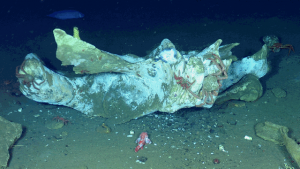
A new paper describes the slowly rotting skeleton of a whale on the seafloor near the South Sandwich Islands, between South America and Antarctica. Why is such a thing exciting to geologists? There are a couple of reasons.
When whales die, they drop dead wherever they happen to be. If they beach themselves first, their corpses lie on the beach, but most whales pass away at sea and sink. Once on the seafloor, their decomposing bodies, called "whale falls," amount to a winning lottery ticket for a host of creatures, which gather around the corpses and settle in to live off them. The flesh goes first, then come the fat-filled bones. The biological communities that arise may last for decades, perhaps centuries, depending on the local conditions.
Biologists are interested in whale falls as lovely self-contained examples of oceanic food chains. Geologists see whale falls as a rich study in taphonomy, their name for everything that happens to organisms as they become fossilized.
If you think about the exquisite fossils you see in museums, the marvel is how clean they are, as if a taxidermist had prepared them for burial. But nature is a lousy taxidermist. For every perfect museum skeleton there are drawers backstage stuffed with thousands of bony fragments, incomplete and imperfect in many ways. But what the fossil collector sees as lamentable damage, the paleontologist—specifically the taphonomist—sees as possible environmental data. Everything from the tooth marks of scavengers to the scrapes made by construction-site bulldozers is the kind of evidence that geology prizes for insight into the living world of the deep past.
Some of the first whale falls studied by scientists were found by the U.S. Navy while they were searching for something they'd dropped. Most whale-fall research, however, is done on carcasses that are towed away from beaches and deliberately placed on the seafloor. That kind of research is quite young, though, and to learn about the late stages of whale-fall existence we need natural examples that are older. It is way too expensive to just dive down and look around for them, so we have to grab the opportunities that arise while we're looking for other things.